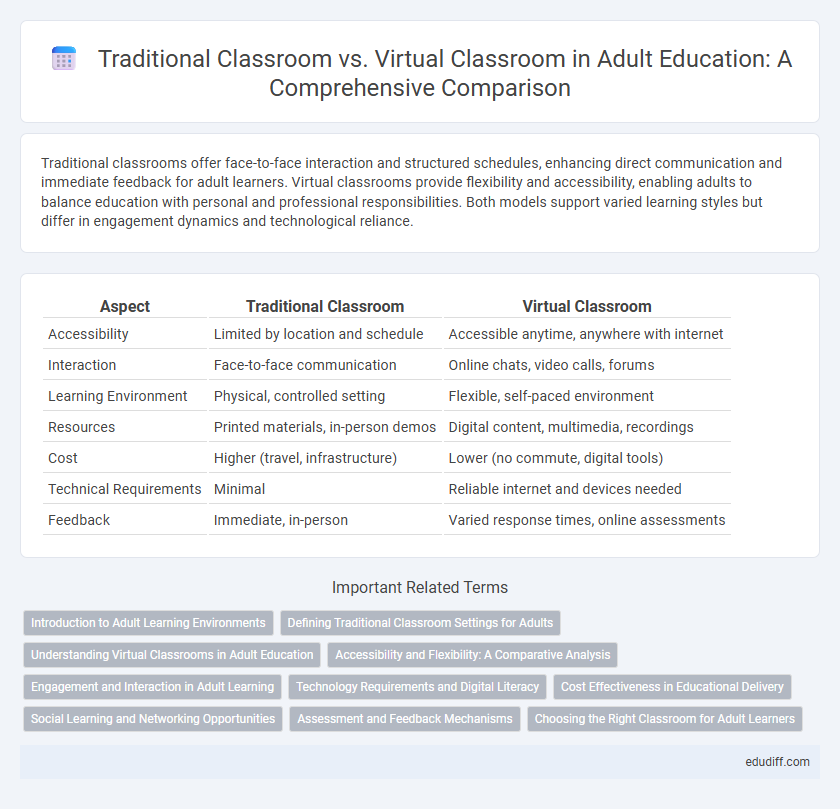Traditional classrooms offer face-to-face interaction and structured schedules, enhancing direct communication and immediate feedback for adult learners. Virtual classrooms provide flexibility and accessibility, enabling adults to balance education with personal and professional responsibilities. Both models support varied learning styles but differ in engagement dynamics and technological reliance.
Table of Comparison
| Aspect | Traditional Classroom | Virtual Classroom |
|---|---|---|
| Accessibility | Limited by location and schedule | Accessible anytime, anywhere with internet |
| Interaction | Face-to-face communication | Online chats, video calls, forums |
| Learning Environment | Physical, controlled setting | Flexible, self-paced environment |
| Resources | Printed materials, in-person demos | Digital content, multimedia, recordings |
| Cost | Higher (travel, infrastructure) | Lower (no commute, digital tools) |
| Technical Requirements | Minimal | Reliable internet and devices needed |
| Feedback | Immediate, in-person | Varied response times, online assessments |
Introduction to Adult Learning Environments
Traditional classrooms in adult learning environments provide face-to-face interaction, structured schedules, and immediate feedback, fostering collaborative engagement and hands-on activities. Virtual classrooms leverage digital platforms to offer flexible access, personalized pacing, and diverse multimedia resources that cater to varied learning styles and busy adult schedules. Both environments support adult learners through tailored instructional design, but virtual settings emphasize convenience and accessibility for professional and lifelong education.
Defining Traditional Classroom Settings for Adults
Traditional classroom settings for adults typically involve in-person, face-to-face instruction within a physical environment such as a community college or corporate training center. These settings emphasize direct interaction with instructors and peers, structured schedules, and immediate feedback, fostering a focused learning atmosphere. The tangible presence of educators and the social dynamics among adult learners enhance engagement and accountability in the educational process.
Understanding Virtual Classrooms in Adult Education
Virtual classrooms in adult education leverage digital platforms to provide flexible learning environments tailored to adult learners' schedules and responsibilities. Interactive tools such as video conferencing, discussion forums, and real-time assessments enhance engagement and improve knowledge retention. This modality supports diverse learning styles and enables access to a wide range of educational resources, promoting continuous skill development and professional growth.
Accessibility and Flexibility: A Comparative Analysis
Traditional classrooms offer limited accessibility restricted by geographic location and fixed scheduling, often challenging adult learners balancing work and family commitments. Virtual classrooms provide enhanced flexibility and accessibility through online platforms, allowing learners to access materials anytime and anywhere, accommodating diverse time zones and learning paces. This flexibility significantly increases participation rates and supports continuous education for adults seeking career advancement or skill development.
Engagement and Interaction in Adult Learning
Traditional classrooms offer face-to-face interaction that fosters immediate feedback and dynamic group discussions, enhancing engagement among adult learners. Virtual classrooms utilize interactive tools like polls, breakout rooms, and chat functions to simulate real-time collaboration and maintain learner participation. Both environments demand tailored strategies to maximize interaction, with virtual settings requiring deliberate facilitation to overcome physical distance challenges.
Technology Requirements and Digital Literacy
Traditional classrooms require minimal technology, primarily standard teaching aids like whiteboards and projectors, while virtual classrooms depend heavily on reliable internet access, computers or smart devices, and video conferencing software such as Zoom or Microsoft Teams. Digital literacy is essential for virtual learning, encompassing skills in navigating online platforms, troubleshooting common technical issues, and effectively engaging in digital communication. The disparity in technology requirements and digital proficiency often influences accessibility and the overall learning experience for adult learners in both environments.
Cost Effectiveness in Educational Delivery
Traditional classrooms incur substantial costs including physical infrastructure, maintenance, and commuting expenses, impacting overall educational budgets negatively. Virtual classrooms drastically reduce these overheads by eliminating the need for physical space and allowing access to digital resources, resulting in significant cost savings. Online platforms also enable scalable enrollment and resource sharing, optimizing expenditure while maintaining educational quality for adult learners.
Social Learning and Networking Opportunities
Traditional classrooms foster direct face-to-face interaction, enhancing social learning through spontaneous discussions and collaborative group work that build strong interpersonal networks. Virtual classrooms utilize digital platforms and forums to connect learners globally, enabling diverse networking opportunities and asynchronous social learning that accommodates varied schedules. Both environments support social connections but differ significantly in immediacy and geographic reach of social learning experiences.
Assessment and Feedback Mechanisms
Traditional classrooms offer direct, immediate assessment through in-person tests and oral evaluations, enabling instructors to provide personalized feedback based on non-verbal cues and class participation. Virtual classrooms utilize digital tools such as automated quizzes, discussion forums, and real-time analytics to assess learners' performance and deliver timely, data-driven feedback. Both modalities cater to diverse learning styles but virtual environments allow for more flexible, iterative feedback, enhancing learner engagement and self-paced improvement.
Choosing the Right Classroom for Adult Learners
Adult learners benefit from traditional classrooms by engaging in face-to-face interactions, structured schedules, and immediate feedback from instructors, fostering accountability and hands-on experiences. Virtual classrooms offer flexibility, allowing adults to balance education with work and family commitments, supported by diverse digital resources and asynchronous learning options. Choosing the right classroom depends on individual learning styles, time availability, and technological proficiency, ensuring optimal engagement and knowledge retention.
Traditional Classroom vs Virtual Classroom Infographic

 edudiff.com
edudiff.com